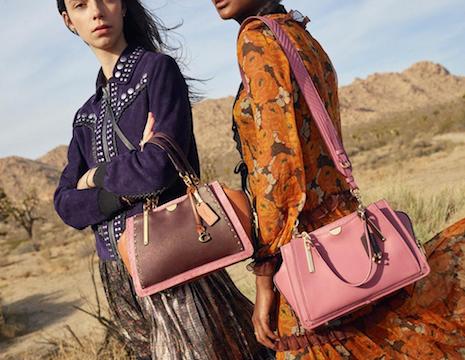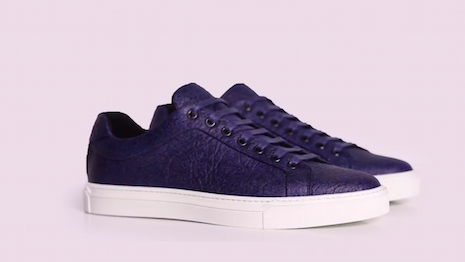 Kate Spade's parent company Tapestry is on a sustainability journey. Image credit: Kate Spade
Kate Spade's parent company Tapestry is on a sustainability journey. Image credit: Kate Spade
NEW YORK – Rather than being a burden, making moves into sustainability can boost a company’s business, but getting consumers on board will be key to achieving green goals.
During the Apparel Importers Trade & Transportation Conference on Nov. 7, a session on sustainability delved into both the ways that brands are innovating as well as the challenges they are facing. From alternative textile sourcing to employee engagement, companies are rolling out initiatives across their operations, but beyond their own supply chain, they should be thinking about a product’s post-consumer life.
"We want to be a responsible business," said Amanda Lechenet, senior manager for sustainability and legal compliance at Tapestry.
"And we really think some of our charge is to create a better place for our children down the line," she said. "So how do we do that keeping in mind that there’s impacts greater than just our footprint here?"
Goals and getting there
Tapestry recently adopted the United Nations’ Sustainable Development Goals, joining about 10,000 other companies including Kering, Burberry, L’Oreal and LVMH.
Claire Kells, senior manager of participant engagement at the UN Global Compact, explained that these cover everything from the environment to social causes. With the sheer number of SDGs, it can be daunting for brands to figure out what to tackle, but consulting tools such as the UN’s compass can help them prioritize.
Tapestry’s Ms. Lechenet explained that for the company, sustainability is a more recent endeavor. The group, which includes Coach, Kate Spade and Stuart Weitzman, recently moved into a LEED certified headquarters.
For Tapestry, leveraging the SDGs set by the UN allows it to have a global platform for talking to worldwide employees about sustainability, centered on the group's own pillars of employee empowerment, community engagement and environmental responsibility.
Tapestry has taken steps to be more sustainable. Image credit: Coach
Fashion in particular has a significant impact on the environment. Looking to change this, NGO Canopy is working to reduce and eventually eradicate the use of endangered forests for fabric sourcing.
Viscose, a fabric made of wood pulp, has grown in popularity in recent years. Today, it is used for applications beyond apparel, including bedding.
Canopy, which counts Stella McCartney, Kering and Nordstrom among its partners, is working with producers to innovate the textile. Viscose has been made out of everything from recycled fibers to agricultural residue, giving the material less of an ecological impact.
One of the producers that works with Canopy is Lenzing. The firm has developed a traceable Viscose with the brand name Ecovero, allowing those down the supply chain to have peace of mind.
Lenzing also recently launched Refibra, which is made of recycled post-industrial cotton waste mixed with wood pulp.
Material world
Canopy’s senior corporate campaigner Sophika Kostyniuk noted that beyond viscose, brands have been using alternative fibers to make fabrics as well.
For instance, German fashion brand Hugo Boss took a unique spin on sustainable fashion design with the launch of footwear created with pineapple leaves.
The products are called Pinatex shoes and they use specially treated pineapple leaves in place of more traditional leathers to create a product that is more sustainable while remaining stylish. The focus on unique materials is in response to a growing trend among fashion consumers desiring products that have less of a drastic negative impact on the environment (see story).
The Pinatex shoes use far fewer resources than regular leather. Image credit: Hugo Boss
Meanwhile, Italian fashion house Salvatore Ferragamo demonstrated its dedication to sustainability with the first apparel collection created from fabric derived from citrus fruits. Ferragamo’s Orange Fiber Collection is a project rooted in sustainability and innovation, ahead of international Earth Day celebrations April 22, 2017 (see story).
One of the challenges for the supplier is explaining the textiles to consumers, according to Tricia Carey, director of business development for Lenzing. She said that the end of life cycle is something that the industry is grappling with, as commonly used mixed textiles such as spandex blends make it difficult to recycle fabric.
As luxury companies strive to be more sustainable, a key part of their efforts should revolve around consumer education, according to a report from Fashionbi.
The last stages in a product’s lifecycle are often among the most wasteful, since consumers today purchase more clothing than before and more frequently discard garments. Per Fashionbi's "Sustainability In The Fashion Industry" report, brands can play a role in shifting consumption patterns through awareness initiatives and a focus on creating better quality, longer lasting fashion (see story).
"The mountain we need to climb and the additional benefit to all of us will be how we communicate to the consumer and how we have the consumer reward us in the marketplace for making these investments and bringing these products to market," said Anna Walker, senior director of global policy and advocacy at Levi Strauss & Co. "So I think that’s the next phase for us all to work together on how we bring the consumer along in the journey and have them actually be the push rather than having to pull them along in the conversation."

